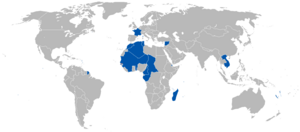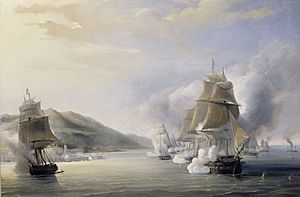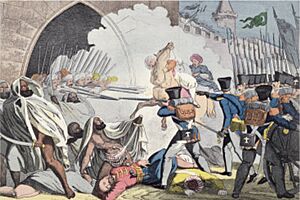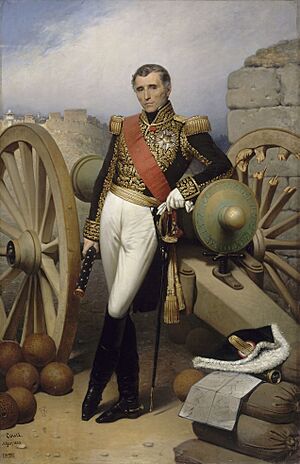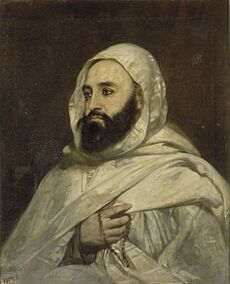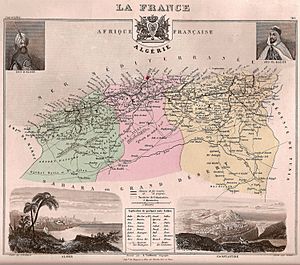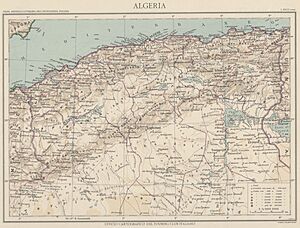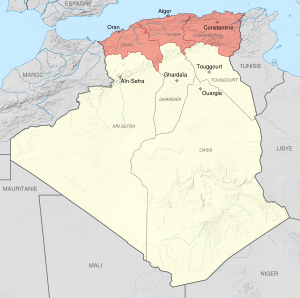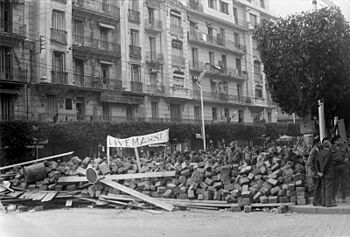French Algeria facts for kids
Quick facts for kids
French Algeria
|
|||||||||||||||
|---|---|---|---|---|---|---|---|---|---|---|---|---|---|---|---|
| 1830–1962 | |||||||||||||||
|
Anthem: La Parisienne (1830–1848)
Le Chant des Girondins (1848–1852) Partant pour la Syrie (1852–1870) La Marseillaise (1870–1962) |
|||||||||||||||
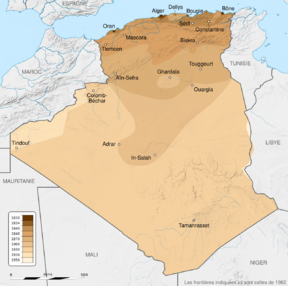
Chronological map of French Algeria's evolution
|
|||||||||||||||
| Status | 1830–1848: French colony 1848–1962: Part of France |
||||||||||||||
| Capital and largest city
|
Algiers | ||||||||||||||
| Official languages | French | ||||||||||||||
| Common languages |
|
||||||||||||||
| Religion | Islam, Roman Catholicism | ||||||||||||||
| Government | French Department | ||||||||||||||
| Governor General | |||||||||||||||
|
• 1830 (first)
|
Louis-Auguste-Victor Bourmont | ||||||||||||||
|
• 1962 (last)
|
Christian Fouchet | ||||||||||||||
| Legislature | Algerian Assembly (1948–1956) |
||||||||||||||
| History | |||||||||||||||
|
• Surrender of Algiers
|
5 July 1830 | ||||||||||||||
| 5 July 1962 | |||||||||||||||
| Area | |||||||||||||||
|
• Total
|
2,381,741 km2 (919,595 sq mi) | ||||||||||||||
| Currency | Budju (1830–1848) (Algerian) Franc (1848–1962) |
||||||||||||||
|
|||||||||||||||
French Algeria was a time in Algerian history when the country was a colony and later a full part of France. This period is also known as Colonial Algeria.
French rule began in 1830 after France successfully invaded Algiers. It lasted until 1962, when Algeria became independent after the Algerian War. From 1830 to 1848, Algeria was a French colony. Then, from 1848 until its independence in 1962, it was considered a "department" or part of France. For a short time (1860-1870), the French emperor Napoleon III tried to give Algerians more freedoms. He also tried to limit how much land French settlers could take. This idea was not popular with the French colonists living there.
Algeria became a place where many Europeans moved. They were first called colons (settlers) and later pieds-noirs. This term especially referred to Europeans born in Algeria. The local Muslim population was always the largest group. Sadly, it's thought that the native Algerian population dropped by up to one-third between 1830 and 1875. This was due to fighting, diseases, and hunger.
Over time, Muslim Algerians became unhappy because they lacked political and economic freedom. They started asking for more self-rule and eventually, full independence from France. Tensions grew between the two groups. In 1954, the first violent events of the Algerian War began. This war involved guerrilla warfare and terrible acts by the French to stop the revolt. The war ended in 1962. Algeria gained independence after the Evian agreements in March 1962 and a vote for self-rule in July 1962.
Contents
- History of French Rule in Algeria
- French Rule in Algeria
- Post-Colonial Relations
- Meaning of Algérie française
- Images for kids
History of French Rule in Algeria
Early Conflicts and Piracy
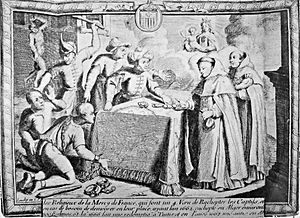
For a long time, Algeria was a base for piracy in the Mediterranean Sea. This started after the Ottoman Empire took over Algiers in 1516. French kings, like Louis XIV, sent their navy to fight these pirates. They also attacked Algiers to help free enslaved Christians.
Later, during the French Directory (1795–99), Jewish merchants in Algiers supplied grain to Napoleon's soldiers. France owed them a lot of money. The ruler of Algiers, called the Dey, had loaned money to these merchants. He asked France to pay its debts.
Algeria was part of the Barbary States, which also included Tunisia. These states were somewhat independent from the Ottoman Empire. The Barbary Coast was a stronghold for pirates. They attacked European and American ships. The United States fought two wars against them (1801–05 and 1815). In 1816, British and Dutch forces also attacked Algiers. The Dey was forced to sign peace treaties. The European and American forces had better weapons and ships.
France first called the Algerian territories "French possessions in North Africa." In 1839, they officially named these lands "Algeria."
France Takes Control of Algeria
The invasion of Algeria began under Charles X, the French king. He hoped to become more popular in France by winning a war. He wanted to make people feel patriotic and distract them from problems at home.
The Fly Whisk Incident (1827)
In the 1790s, France bought wheat from two merchants in Algiers. France was very late in paying them back. These merchants owed money to the Dey of Algiers. The Dey tried to talk to Pierre Deval, the French consul, about this problem. He suspected Deval was working against him.
On April 29, 1827, during an argument, the Dey hit Deval with his fly whisk. King Charles X used this insult as an excuse. First, he demanded an apology from the Dey. Then, he started a blockade of Algiers' port. When the Dey fired cannons at one of the French ships, France decided to take stronger action.
The Invasion of Algiers (1830)
French Admiral Guy-Victor Duperré led a large fleet of 600 ships to Algiers. On June 14, 1830, General de Bourmont landed with 34,000 soldiers west of Algiers. The Algerian Dey's forces tried to stop them. But the French had better artillery and organization.
The French won a key battle on June 19. They entered Algiers on July 5, after a three-week fight. The Dey surrendered and was allowed to keep his wealth. He left Algeria with his family. Many of his soldiers also left.
The French army then started recruiting local soldiers. They took over land that belonged to Turkish settlers. In the western region, the Sultan of Morocco, Abderrahmane, supported the Algerian resistance. This resistance was led by Abd El-Kader. He fought against the French for many years.
Soon after Algiers was captured, King Charles X was removed from power in France. A new king, Louis-Philippe, took over. His government was not sure about continuing the conquest. But leaving Algeria proved to be difficult.
Some people, like Alexis de Tocqueville, believed France should fully control and colonize Algeria. They thought the French military should fight against the local people. A colonial government would then rule the cities.
Was it a Genocide?
Some governments and experts have called France's conquest of Algeria a genocide. For example, Ben Kiernan, an expert on genocides, wrote that the war killed about 825,000 Algerians by 1875. He noted that some French people even suggested destroying the native population.
When France recognized the Armenian genocide, Turkey accused France of committing genocide against Algerians.
Algerian Resistance to French Occupation
Conquest Under the July Monarchy (1830–1848)
In 1830, King Louis-Philippe sent the Duc de Rovigo to lead the military in Algeria. He started colonizing the land. But he was recalled in 1833 because his actions were too violent.
In 1834, France officially made the occupied areas of Algeria a colony. These areas had about two million Muslim people. A governor-general, a high-ranking army officer, was put in charge. He had both civil and military power. Marshal Bugeaud became the first governor-general and led the conquest.
French officials and settlers started taking over agricultural land. They wanted to grow crops like cotton. This made many government officials interested in expanding French control in Algeria. They created large farms and businesses, hiring local workers.
Some French officers wrote about the harsh methods used. Lieutenant-colonel Lucien de Montagnac wrote in 1843 that all people who did not accept French rule should lose their land. He said everything should be taken and destroyed, without caring about age or gender.
France was worried that Britain might try to take over Algeria if they left. So, they decided to strengthen their presence. They tried to build a new government in Algeria. But this was hard because of strong armed resistance.
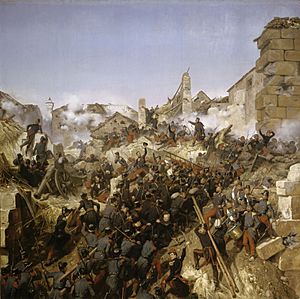
One of the strongest local leaders was Ahmad ibn Muhammad, the ruler of Constantine. He changed the Ottoman government in his area. He replaced Turkish officials with local leaders and made Arabic the official language. The French tried to take his lands but failed in 1836. However, they captured Constantine the next year, on October 13, 1837.
Historians believe Algeria had about 3 million people in 1830. The population decreased later, especially between 1866 and 1872. This was partly due to French military actions. But it was also caused by locust plagues, a harsh winter, and a famine followed by a cholera outbreak.
Lalla Fadhma N'Soumer's Resistance
When France started colonizing Algeria, the Kabylia region remained independent. Its people were determined to resist. Around 1849, a mysterious man named Mohamed ben Abdallah, also known as Sherif Boubaghla, arrived. He was likely a former soldier of Emir Abdelkader. Boubaghla started a war against the French using guerrilla warfare. He was a strong leader and very religious.
Lalla Fadhma N'Soumer was a powerful woman who joined the resistance. She was inspired by Boubaghla. Her speeches convinced many men to fight as imseblen (volunteers ready to die). She and other women helped by cooking, providing medicines, and comforting the fighters.
Lalla Fadhma was present at many battles with Boubaghla. One famous battle was Tachekkirt (July 18–19, 1854), where the French general Jacques Louis César Randon was captured but escaped. Boubaghla was killed in December 1854. After his death, a council decided that Lalla Fadhma, with her brothers, would lead the resistance.
Emir Abd al Qadir's Resistance
Another important leader was Abd al Qadir. He was a religious leader who started attacks against the French in 1832. Tribal elders chose him to lead a jihad (holy war). Abd al Qadir quickly gained support across Algeria. He was a clever political leader and a skilled warrior.
From his capital in Tlemcen, Abd al Qadir built a Muslim state. By 1839, he controlled over two-thirds of Algeria. His government had an army, collected taxes, supported education, and built public works.
The French were worried about his success. Abd al Qadir fought many battles against French forces. Even though he was defeated in 1836, he signed a peace treaty that recognized his rule. This helped him keep his power among the tribes. However, the French broke the treaty in 1839 by occupying Constantine.
Abd al Qadir started the holy war again. He destroyed French settlements and even reached the edge of Algiers. He attacked where the French were weakest and retreated when they were stronger. But the French had more soldiers and resources. By 1843, his state had fallen apart.

Abd al Qadir sought safety with the Sultan of Morocco, Abd ar Rahman II. He launched raids into Algeria from Morocco. This led the French Navy to attack and briefly occupy Essaouira in Morocco in 1844. Abd al Qadir was forced to surrender to the French in late 1847.
He was promised safe passage to Egypt or Palestine if his followers stopped fighting. But the French minister of war, who had been defeated by Abd al Qadir years earlier, had him imprisoned in France.
French Rule in Algeria
European Settlers and Their Influence
Many Europeans moved to Algeria after the French conquest. They were called colons (settlers) or later pieds noirs. Most came from poor areas of Italy, Spain, and France. Some were also criminals or political prisoners sent from France.
The French government encouraged settlement by offering land grants. This led to a difference between grands colons (wealthy settlers) who owned large estates, and small farmers or workers who often struggled. By 1848, only 15,000 of 109,000 European settlers lived in rural areas. But their actions of taking land greatly changed traditional Algerian society.
Political Control
In 1845, France set up three types of administration in Algeria. In areas with many Europeans, settlers elected their own mayors and councils. In "mixed" areas, where Muslims were the majority, French officials and some elected local leaders governed. Remote areas, not fully controlled, remained under military rule.
By 1848, most of northern Algeria was under French control. The "Arab Bureaus" were important. These were staffed by French officers who knew Arabic. They collected information and helped with administration, working with the army. Sometimes, they helped protect the local people from the settlers.
The settlers often complained about military rule. They wanted a civil government for Algeria, fully connected to France. The army warned that civilian rule might lead to Muslim uprisings. The French government tried to balance these demands.
Changes Under French Republics
Second Republic and Second Empire (1848–1870)
In 1848, France's new government declared Algeria an official part of France. Three civil territories—Alger, Oran, and Constantine—became French "departments." French citizens in these areas could elect their own councils. Muslims could not be mayors and had limited representation. Areas outside these settler zones remained under French Army control.
Napoleon III visited Algeria in the 1860s. He was impressed by the local leaders and disliked the greedy settlers. He wanted to stop European settlement beyond the coast. He dreamed of an "Arab kingdom" in Algeria, with himself as its king. He tried to work directly with traditional Muslim leaders.
Napoleon III issued two decrees to change tribal structures and land ownership. The first, in 1863, aimed to give private land plots to tribes. This was meant to protect their lands from settlers. However, French officials often took tribal land for public use. Also, some tribal leaders sold communal lands quickly.
The second decree, in 1865, recognized cultural differences. Muslims could serve in the French army and civil service. They could also move to France. They were protected by French law but could still follow Islamic law for personal matters. But if Muslims wanted to become full French citizens, they had to accept all French laws, including those on marriage and inheritance. This meant giving up some religious customs, which was seen as a betrayal by many Muslims. Very few Muslims chose to become full French citizens.
Third Republic (1870–1940)
When Napoleon III was captured in 1870, the Second Empire ended. The new French government aimed to fully connect Algeria with France. In October 1870, Adolphe Crémieux issued decrees. These gave Algerian Jews full French citizenship (about 40,000 people). This set them apart from Muslims.
After France lost land to Prussia in 1871, about 5,000 French refugees were resettled in Algeria. This led to more European-owned land and more settlers. Tens of thousands of Muslims lost their land and had to search for work in cities or on settler farms.
Kabylia Uprising (1871)
A major uprising happened in 1871 in Kabylia. It spread across much of Algeria. The revolt started because the French government changed rules for tribal lands. Also, a severe drought from 1866 caused famine and disease. Many Muslims died from hunger. When the French authorities refused to help with seed for crops, even pro-French Muslim leaders became angry.
The uprising began after Muslim soldiers in the French Army refused to go to France. France had also moved many soldiers from Algeria to fight in the Franco-Prussian War. This weakened their control.
After the uprising, France punished the Muslim population harshly. They took over 5,000 square kilometers of tribal land. Kabylia was put under "extraordinary rule," meaning people lost basic legal rights. A special "native code" listed minor acts as offenses. The governor-general could jail suspects for up to five years without trial. Some Algerians were sent to New Caledonia.
Expanding South
In the 1890s, France wanted to take over the Touat, Gourara, and Tidikelt regions in the southwest. These areas were part of Morocco but not fully controlled by its government. After some fighting, France annexed these regions in 1901.
Later, in the 1930s, the Saoura valley and Tindouf region were also added to French Algeria. This happened at the expense of Morocco, which was then a French protectorate.
The French also explored and took control of parts of the Sahara Desert. They used camel corps, mainly recruited from the Chaamba nomadic tribe, to police the desert. In 1902, French forces defeated the Ahaggar Tuareg in the battle of Tit.
During World War II (1940–1945)
Algerian colonial troops fought for France in 1940. After France fell to Germany, the French State took over. In July 1940, the British Navy attacked the French fleet at Mers El Kébir, killing over 1,200 men.
Under the Fourth Republic (1946–1958)
Many Algerians fought for France in World War II. They felt it was unfair that their votes were not equal to other Algerians. In 1947, the Algerian Assembly was created. Muslims, who were about 6.85 million people, could choose half of the members. Non-Muslims, about 1.15 million people, chose the other half.
A terrible event happened in Sétif on May 8, 1945. Algerians were protesting for their rights. After clashes with police, Algerians killed about 100 French people. The French army responded very harshly, killing around 6,000 Algerians. This event made Algerian nationalists more determined. Many consider it the start of the Algerian War.
By 1956, about 512,000 French soldiers were in Algeria. There was no easy solution. Most French politicians did not want Algeria to be independent. But more and more Muslim Algerians wanted independence. This disagreement caused the French Fourth Republic government to collapse.
Under the Fifth Republic (1958–1962)
In 1958, Charles de Gaulle returned to power after a military uprising in Algiers. He was expected to keep Algeria as part of France. He even shouted "Long live French Algeria!" in his speeches. De Gaulle's new constitution was approved, and the Fifth Republic began with him as president.
However, de Gaulle later agreed to Algeria's independence in 1962. This happened after a vote on Algerian self-determination in January 1961. There was even an attempted military coup in Algiers in April 1961 by French generals who wanted to keep Algeria French.
Post-Colonial Relations
Relations between Algeria and France have remained close but sometimes difficult. The 1962 Évian Accords peace treaty allowed the French Army to keep land in the Sahara for nuclear tests. Many European settlers (pieds-noirs) and Algerian Jews moved to France.
The issue of the harkis (Muslims who fought for France) remains unresolved. Many harkis were killed in 1962. Those who escaped to France often faced difficulties. The current Algerian government does not allow harkis and their families to return.
In 2005, a French law was passed that said teachers must teach the "positive values" of colonialism. This caused a big public outcry and was later removed. Critics said it was trying to change history.
In 2017, President Emmanuel Macron called France's colonization of Algeria a "crime against humanity." He said France needed to apologize for these acts.
In July 2020, the remains of 24 Algerian resistance fighters were returned to Algeria. These fighters were executed by French forces in the 1800s. Their skulls had been kept in a museum in Paris as war trophies.
In January 2021, Macron stated there would be "no repentance nor apologies" for the colonization. Instead, efforts would focus on reconciliation between the two countries.
Meaning of Algérie française
Algérie française was a slogan used around 1960. It meant that Algeria should remain under French rule. It implied that Algeria's three departments were full parts of France. This meant they would have representatives in the French National Assembly. People who supported this idea believed that only those who accepted French law (not Islamic law) should vote. These were mostly people of French or Jewish origin.
In Paris, people would honk their car horns in a special way to show support for Algérie française. It was four short honks followed by a long one. This was like the "V for Victory" signal from World War II. It meant that those who opposed French Algeria were seen as traitors.
Images for kids
-
Purchase of Christian slaves by French monks in Algiers in 1662
-
The capture of Constantine by French troops, 13 October 1837 by Horace Vernet
-
The Battle of Smala, 16 May 1843. Prise de la smalah d Abd-El-Kader à Taguin. 16 mai 1843, by Horace Vernet
-
Arrival of Marshal Randon in Algiers in 1857
-
Arzew inhabitants meet U.S. Army Rangers in November 1942 during Allied Operation Torch




